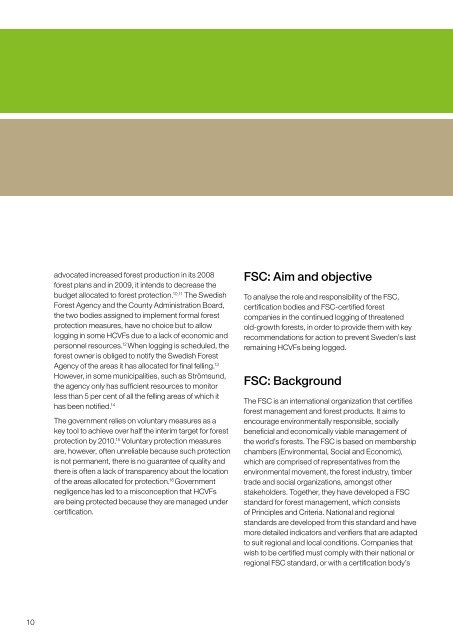Under the Cover of Forest Certification - Greenpeace
Under the Cover of Forest Certification - Greenpeace
Under the Cover of Forest Certification - Greenpeace
You also want an ePaper? Increase the reach of your titles
YUMPU automatically turns print PDFs into web optimized ePapers that Google loves.
advocated increased forest production in its 2008<br />
forest plans and in 2009, it intends to decrease <strong>the</strong><br />
budget allocated to forest protection. 10,11 The Swedish<br />
<strong>Forest</strong> Agency and <strong>the</strong> County Administration Board,<br />
<strong>the</strong> two bodies assigned to implement formal forest<br />
protection measures, have no choice but to allow<br />
logging in some HCVFs due to a lack <strong>of</strong> economic and<br />
personnel resources. 12 When logging is scheduled, <strong>the</strong><br />
forest owner is obliged to notify <strong>the</strong> Swedish <strong>Forest</strong><br />
Agency <strong>of</strong> <strong>the</strong> areas it has allocated for final felling. 13<br />
However, in some municipalities, such as Strömsund,<br />
<strong>the</strong> agency only has sufficient resources to monitor<br />
less than 5 per cent <strong>of</strong> all <strong>the</strong> felling areas <strong>of</strong> which it<br />
has been notified. 14<br />
The government relies on voluntary measures as a<br />
key tool to achieve over half <strong>the</strong> interim target for forest<br />
protection by 2010. 15 Voluntary protection measures<br />
are, however, <strong>of</strong>ten unreliable because such protection<br />
is not permanent, <strong>the</strong>re is no guarantee <strong>of</strong> quality and<br />
<strong>the</strong>re is <strong>of</strong>ten a lack <strong>of</strong> transparency about <strong>the</strong> location<br />
<strong>of</strong> <strong>the</strong> areas allocated for protection. 16 Government<br />
negligence has led to a misconception that HCVFs<br />
are being protected because <strong>the</strong>y are managed under<br />
certification.<br />
FSC: Aim and objective<br />
To analyse <strong>the</strong> role and responsibility <strong>of</strong> <strong>the</strong> FSC,<br />
certification bodies and FSC-certified forest<br />
companies in <strong>the</strong> continued logging <strong>of</strong> threatened<br />
old-growth forests, in order to provide <strong>the</strong>m with key<br />
recommendations for action to prevent Sweden’s last<br />
remaining HCVFs being logged.<br />
FSC: Background<br />
The FSC is an international organization that certifies<br />
forest management and forest products. It aims to<br />
encourage environmentally responsible, socially<br />
beneficial and economically viable management <strong>of</strong><br />
<strong>the</strong> world’s forests. The FSC is based on membership<br />
chambers (Environmental, Social and Economic),<br />
which are comprised <strong>of</strong> representatives from <strong>the</strong><br />
environmental movement, <strong>the</strong> forest industry, timber<br />
trade and social organizations, amongst o<strong>the</strong>r<br />
stakeholders. Toge<strong>the</strong>r, <strong>the</strong>y have developed a FSC<br />
standard for forest management, which consists<br />
<strong>of</strong> Principles and Criteria. National and regional<br />
standards are developed from this standard and have<br />
more detailed indicators and verifiers that are adapted<br />
to suit regional and local conditions. Companies that<br />
wish to be certified must comply with <strong>the</strong>ir national or<br />
regional FSC standard, or with a certification body’s<br />
10

















